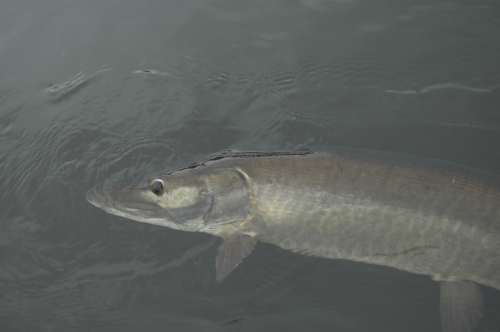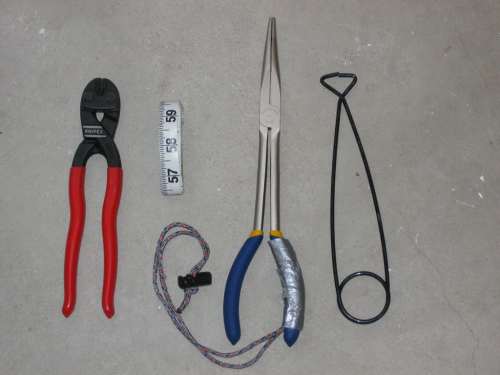
Tools and
Traits for Properly Releasing Muskie
By
Tim Allard
Muskie fishing is one of the fastest growing
areas in sport fishing today. Ask any long-time muskie angler if fishing
pressure is increasing, or look at the growth of muskie lure
manufacturers, and you'll be convinced that muskie fishing is on the rise.
With more anglers pursuing these predators every year, the need for proper
releasing techniques is crucial to ensure the survival of post-release
fish and sustain the sport fishery.

A muskie recuperates prior to returning to its watery haunts.
The Right Tools and Gear
When muskie fishing, you need the right tools to fish, to play and to
release a muskie without exhausting or over-stressing the fish. The right
tools begin with your fishing equipment. Your set-up should include heavy
action rods, and reels with high ratios and large spools to quickly
retrieve line. Spool reels with quality line with a minimum rating of
65-pound-test. The terminal end should have steel leader with strong snaps
and ball bearing swivels.
You will need the right tools to land and
release these big predators. Opinions vary on the best device to land a
muskie, but nets and cradles (large enough to comfortably hold, or pen, a
muskie) are two popular options. You will also need tools to help cut and
remove hooks from the fish's mouth, including: long-nosed pliers, hook
cutters, jaw spreaders, and hook-removers. Remember, cutting hooks can be
faster than removing them with pliers, but it is critical to remove all
the hook pieces. Pieces left in the fish can lead to infection and,
potentially, death.

Pictured left to right are some common tools for releasing muskie: hook
cutters, measuring tape, long-nose pliers, and jaw-spreaders.
Have the Knowledge
You've just spent a couple hundred dollars on a quality net, a rod and
reel combo, a dozen lures, and the latest release tools. Better yet,
you're on a beautiful lake and have a hefty muskie at the boat. Adrenaline
rushes through your body, but are you prepared to safely land this fish?
This is an important question anglers new to muskie fishing need to ask
themselves before fishing. Lipping a trophy bass, or netting a fat
walleye, requires skill and confidence, but handling big, aggressive fish
is more demanding. The good news is there are many ways to learn how-to
land and release muskies properly.
One of the best ways to learn is by doing.
I'm thankful to the experienced anglers that I've fished, and continue to
fish, with who have helped me learn how-to properly release fish. Joining
a club like Muskies Canada or Muskies Inc. will connect you to a wealth of
muskie information. Hiring a credible guide is another way to gain
first-hand experience. Reading publications specific to muskie fishing and
attending seminars at fishing shows are two other ways to boost your
release know-how.
Confidence and Patience
"Zen and the art of muskie fishing?" you ask. No, but these two traits
will go a long way to ensure you properly release fish. When working in
close quarters with muskie, you must be confident in your actions; this is
where the right tools and knowledge will really pay off. For example, if
you're leaning over to grab a shovelhead and you hesitate just as the fish
thrashes in the net, the situation could quickly get dangerous to both you
and the fish. Most multi-season, muskie anglers know stories of hooks in
hands and fish freak-outs. Being confident when handling muskie will
likely save you a hospital visit, but it can't guarantee it - that's part
of the allure of muskie fishing.
Being patient comes into play on many levels in fishing, but let's focus
on how it relates to releasing these toothy brutes. After hooking a muskie
you intend to release (which should be almost always) you're responsible
to do it properly. Muskies may battle hard during the fight, but require
time to recuperate before swimming away. Maybe it only takes 10 minutes,
some fish may take 20, and some can need more than an hour of boat-side
support. As a responsible angler, you must be patient enough to hold and
support that fish as it regains its strength before being able to strongly
swim out of your hands. If you're not prepared to spend the time to
properly release a fish, you shouldn't be fishing in the first place. It's
that simple.
Be Organized
Being organized is more than just having the right tools and gear
accessible in a tidy and hazard-free boat. It's fishing with a partner and
knowing your responsibilities once a fish is hooked. While one battles the
fish, the other should ready the release tools, camera, measuring tape and
landing device.
Having a plan for playing and releasing fish,
and keeping all tools needed within reach, reduces handling time and
overall stress to the fish. Furthermore, a planned and properly executed
process for landing, handling and releasing fish will ensure the fish is
kept in the water as much as possible. Key to any successful release is
keeping the fish (especially its head) in the water at all times, and only
removing it for a quick photo if necessary. Some anglers let the fish
recuperate in a net or cradle after the hooks are removed before handling
the muskie again to take a picture. When photographing fish, a good rule
of thumb is to hold your breath as you lift the fish out of the water.
When you need to breathe, so does the fish and it should quickly be
returned to the water to minimize harm.
Release methods for muskie can spark debate
among anglers concerned with preserving the fishery. I've tried to stay
clear of any controversial topics in this article, providing some
best-practices for releasing muskies. Try these tips the next time your on
the water for proper muskie releases.
Back
To Main Page
[Kawarthas Weather] [Kawarthas
Directory] [Subscribe
to our FREE fishing e-magazine] [Ontario
Fishing Network] [Ontario
Fishing Classifieds]
[Ontario Fishing Videos]
[Ontario Fishing Photo
Gallery] |